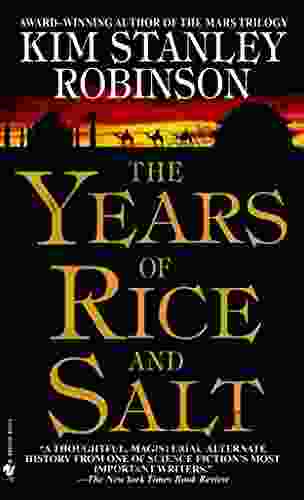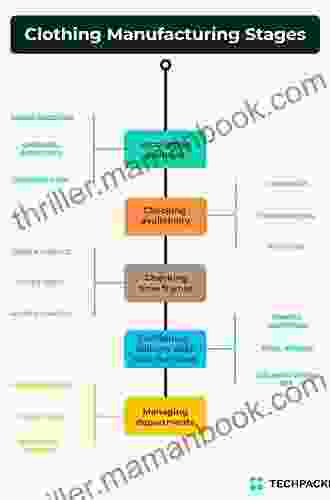The Intricate Design of Clothing Manufacturing Processes: A Comprehensive Guide

The clothing industry is a vast and complex global network, involving numerous processes and stakeholders at various stages. From the initial design concept to the final retail product, the manufacturing journey of a garment is meticulously planned and executed, ensuring efficiency, quality, and customer satisfaction.
1. Design and Development
The design phase is the foundation of the clothing manufacturing process. Designers collaborate with fashion experts and industry professionals to create sketches, mood boards, and prototypes. They consider market trends, target demographics, and the latest fashion innovations to develop garments that align with consumer preferences.
4.8 out of 5
| Language | : | English |
| File size | : | 13028 KB |
| Text-to-Speech | : | Enabled |
| Screen Reader | : | Supported |
| Enhanced typesetting | : | Enabled |
| Print length | : | 450 pages |
Once the design is finalized, technical designers translate the sketches into detailed technical drawings. These drawings specify the garment's dimensions, fabric requirements, stitching instructions, and other technical details that guide the production process.
2. Fabric Sourcing and Procurement
With the design specifications in place, manufacturers engage in fabric sourcing and procurement. They research different fabric options based on the garment's intended use, durability, and cost. Mills and suppliers are contacted to obtain samples and negotiate prices and delivery schedules.
Fabric selection is critical as it influences the garment's comfort, performance, and aesthetics. Factors such as fiber composition, weave type, weight, and color are carefully considered to meet design requirements and customer expectations.
3. Pattern Making and Grading
After fabric sourcing, pattern makers create patterns for the garment's individual pieces. These patterns serve as templates for cutting and sewing the fabric. Pattern making requires precision and attention to detail to ensure the garment fits perfectly.
Once the patterns are made, they are graded to create different sizes. Grading involves modifying the patterns slightly to adjust for variations in body measurements, ensuring consistent sizing across the range of sizes offered.
4. Cutting and Sewing
The cutting stage involves cutting the fabric according to the pattern pieces. Automated cutting machines are often used for large-scale production, while smaller workshops may use manual cutting methods.
The cut pieces are then assembled through sewing. Skilled sewers use industrial sewing machines to stitch the pieces together according to the technical drawings. The type of stitch and thread used depends on the fabric and the intended purpose of the garment.
5. Finishing and Quality Control
After sewing, garments undergo various finishing processes to enhance their appearance and durability. These processes may include pressing, ironing, embellishment, and labeling.
Quality control is an integral part of the manufacturing process. Garments are inspected at each stage to ensure they meet the desired quality standards. Faulty or non-conforming garments are identified and repaired or discarded.
6. Packaging and Shipping
Once the garments are finished and approved, they are packaged and prepared for shipping to retailers and consumers. The choice of packaging materials and methods depends on the garment's size, shape, and intended transportation route.
Efficient packaging and shipping ensure the garments arrive at their destination in good condition and on schedule, ensuring customer satisfaction and brand reputation.
7. Sustainability and Environmental Considerations
In recent years, the clothing industry has faced increasing scrutiny regarding its environmental impact. As a result, manufacturers are incorporating sustainable practices into their processes.
These practices may include using eco-friendly materials, reducing energy consumption, optimizing waste management, and adopting ethical labor practices. By addressing environmental concerns, manufacturers contribute to a more sustainable and responsible industry.
The design of clothing manufacturing processes is a complex and dynamic field, influenced by evolving consumer preferences, industry trends, and advancements in technology. Manufacturers must continuously optimize their processes to ensure efficiency, quality, and sustainability.
Understanding the intricacies of clothing manufacturing helps consumers make informed decisions about the products they purchase and supports the growth of a responsible and ethical fashion industry.
4.8 out of 5
| Language | : | English |
| File size | : | 13028 KB |
| Text-to-Speech | : | Enabled |
| Screen Reader | : | Supported |
| Enhanced typesetting | : | Enabled |
| Print length | : | 450 pages |
Do you want to contribute by writing guest posts on this blog?
Please contact us and send us a resume of previous articles that you have written.
 Top Book
Top Book Novel
Novel Fiction
Fiction Nonfiction
Nonfiction Literature
Literature Paperback
Paperback Hardcover
Hardcover E-book
E-book Audiobook
Audiobook Bestseller
Bestseller Classic
Classic Mystery
Mystery Thriller
Thriller Romance
Romance Fantasy
Fantasy Science Fiction
Science Fiction Biography
Biography Memoir
Memoir Autobiography
Autobiography Poetry
Poetry Drama
Drama Historical Fiction
Historical Fiction Self-help
Self-help Young Adult
Young Adult Childrens Books
Childrens Books Graphic Novel
Graphic Novel Anthology
Anthology Series
Series Encyclopedia
Encyclopedia Reference
Reference Guidebook
Guidebook Textbook
Textbook Workbook
Workbook Journal
Journal Diary
Diary Manuscript
Manuscript Folio
Folio Pulp Fiction
Pulp Fiction Short Stories
Short Stories Fairy Tales
Fairy Tales Fables
Fables Mythology
Mythology Philosophy
Philosophy Religion
Religion Spirituality
Spirituality Essays
Essays Critique
Critique Commentary
Commentary Glossary
Glossary Bibliography
Bibliography Index
Index Table of Contents
Table of Contents Preface
Preface Introduction
Introduction Foreword
Foreword Afterword
Afterword Appendices
Appendices Annotations
Annotations Footnotes
Footnotes Epilogue
Epilogue Prologue
Prologue William M Adler
William M Adler E Nesbit
E Nesbit Mohamed Ammouri
Mohamed Ammouri Patrick Wang
Patrick Wang Louise Penny
Louise Penny Geoff Strong
Geoff Strong Ruth King
Ruth King Sara Henning
Sara Henning Olatunde Adedayo
Olatunde Adedayo Jack Mittler
Jack Mittler Steven Johnson
Steven Johnson Edd Kimber
Edd Kimber Carl Hoffman
Carl Hoffman Matthew Zapruder
Matthew Zapruder Viola Grace
Viola Grace Chuck Hemann
Chuck Hemann Joshua Coleman Ph D
Joshua Coleman Ph D Jack Kirby
Jack Kirby Melissa Samaroo
Melissa Samaroo Manzur Rashid
Manzur Rashid
Light bulbAdvertise smarter! Our strategic ad space ensures maximum exposure. Reserve your spot today!

 William PowellThe Forever War: A Timeless Exploration of the Horrors and Absurdities of War
William PowellThe Forever War: A Timeless Exploration of the Horrors and Absurdities of War
 Cameron ReedIntroducing Tex Hunter: The Gripping Legal Thriller Series That Will Keep You...
Cameron ReedIntroducing Tex Hunter: The Gripping Legal Thriller Series That Will Keep You... Jeremy MitchellFollow ·12.9k
Jeremy MitchellFollow ·12.9k Octavio PazFollow ·5.9k
Octavio PazFollow ·5.9k Edwin CoxFollow ·18.6k
Edwin CoxFollow ·18.6k Brandon CoxFollow ·18.4k
Brandon CoxFollow ·18.4k Herman MelvilleFollow ·11.3k
Herman MelvilleFollow ·11.3k George R.R. MartinFollow ·4.3k
George R.R. MartinFollow ·4.3k Theo CoxFollow ·2.3k
Theo CoxFollow ·2.3k Thomas PynchonFollow ·5.8k
Thomas PynchonFollow ·5.8k

 Caleb Carter
Caleb CarterThe Complete Beagle Dog Beginners Guide: Beagle Facts,...
Beagles are...

 Gage Hayes
Gage HayesThe Origins and Evolution of No Child Left Behind:...
The No Child Left Behind...

 George Martin
George MartinThe Love Pirates: A Swashbuckling Tale of Love,...
The Love Pirates is a thrilling...

 Nathaniel Hawthorne
Nathaniel HawthorneDifferentiating the Curriculum for Gifted Learners:...
Gifted learners are...

 Carlos Fuentes
Carlos FuentesThe Years of Rice and Salt: A Journey Through a Forgotten...
The Years of Rice and Salt is...

 Herbert Cox
Herbert CoxThe Intricate Design of Clothing Manufacturing Processes:...
The clothing industry is a vast and...
4.8 out of 5
| Language | : | English |
| File size | : | 13028 KB |
| Text-to-Speech | : | Enabled |
| Screen Reader | : | Supported |
| Enhanced typesetting | : | Enabled |
| Print length | : | 450 pages |






